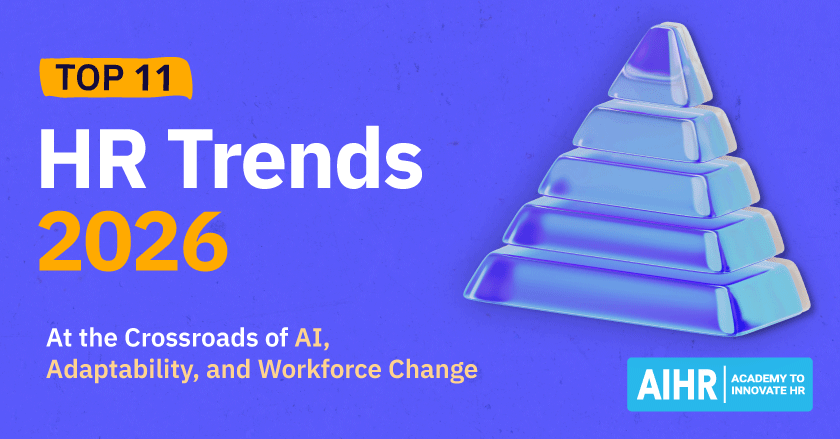AI is transforming HR, but not in the way most people expect. The mainstream narrative often suggests that adoption starts in the boardroom, with Chief Human Resources Officers (CHROs) and senior executives setting the pace while the rest of the function follows. However, the reality is more nuanced.
New analysis from our collaboration partner Lightcast shows how AI in HR is being steered and adopted from within the frontline HR workforce. The earliest and most impactful adoption in successful organizations happens when HR practitioners themselves experiment with, adopt, and reap the benefits of AI at the process and task level.
In this article, we explore how AI is being adopted among HR practitioners, why traditional change management efforts are too slow to keep up with the speed of AI progress, why HR leaders need to play a different role, and why building AI fluency is the key to future progress.
The HR front line is now the starting line
Across the labor market, AI adoption has accelerated at an unprecedented pace. Lightcast data shows that the average job has seen 32% of its skills change in just three years, with AI driving more disruption than any other trend.
Recent Lightcast research found that the demand for AI skills in HR has grown by 66% year over year, which is one of the fastest growth rates among sectors.
| Growth of demand for AI skills across sectors (YoY) | |
| HR | +66% |
| Marketing and PR | +50% |
| Finance | +40% |
| Education and Training | +18% |
| Science and Research | +9% |
While only 2% of HR job postings explicitly require AI skills, that demand is heavily concentrated in frontline roles like talent acquisition (3.9%) and training specialists (1.9%). These findings reflect a similar pattern to AIHR’s AI adoption insights, showing that most (49%) AI adoption in HR is concentrated in talent acquisition.
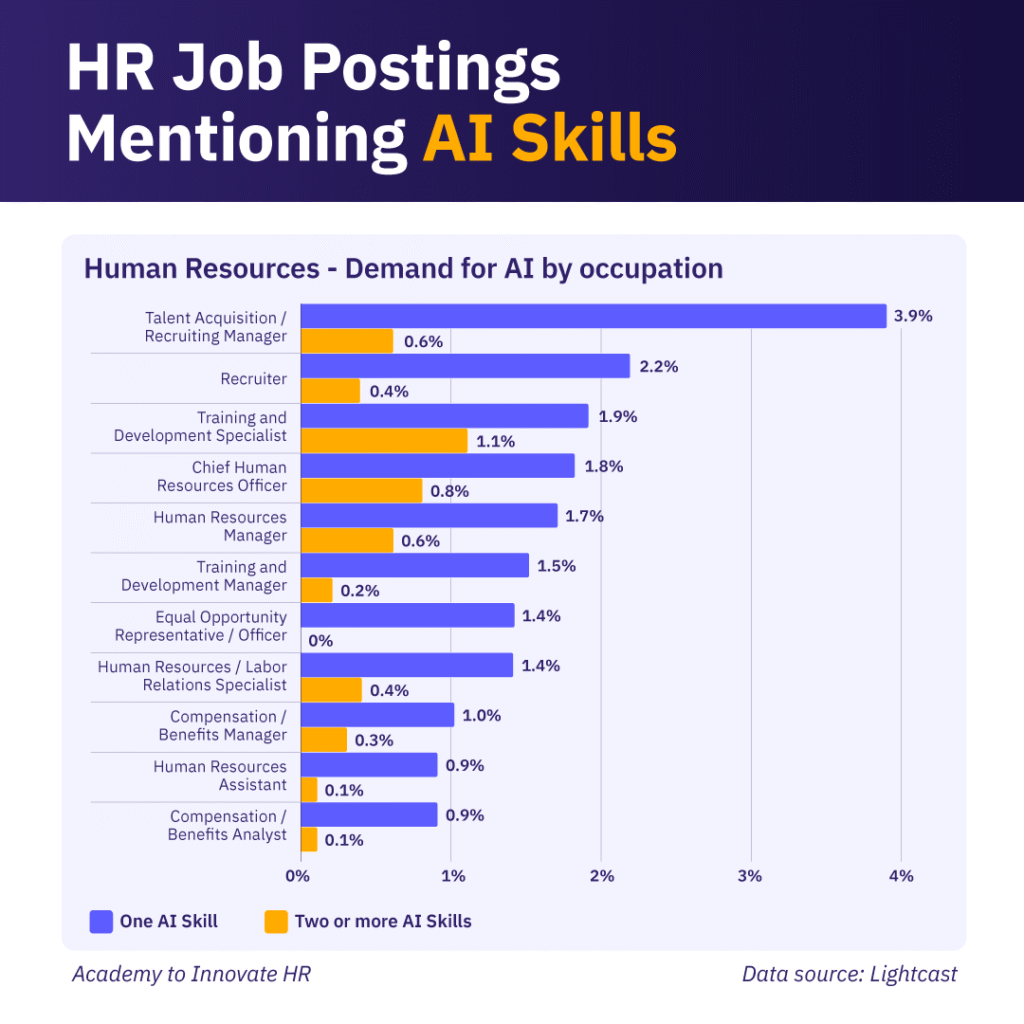
Far from being a future possibility, AI is already woven into HR work today, and the professionals who are closest to day-to-day processes are the ones driving change.
The data reveals a striking pattern: AI adoption in HR starts with practitioners, not executives. Unlike IT or Finance, where senior leaders often pioneer new technology investments, HR is seeing the fastest uptake among those on the ground—the people managing candidates, running training programs, and overseeing employee experiences.
Lightcast’s research highlights this shift clearly:
- Talent acquisition and recruitment practitioners are leading the charge with 3.9% of job postings now requiring an AI skill. Their work is highly process-driven, repetitive, and data-intensive, which makes it a natural fit for AI augmentation. Recruiters are using machine learning to rank candidates, AI chatbots to answer applicant questions, and generative AI to draft custom job postings in seconds. For a recruiter managing hundreds of CVs a week, AI adoption significantly increases productivity while ensuring consistency and quality in execution.
- Training and development specialists are also embracing AI (1.9% of job postings mention an AI skill). They use generative AI to create course outlines, learning activities, and assessments tailored to different roles and skill levels. They are beginning to leverage adaptive learning systems that use AI to adjust and personalize training in real time, ensuring employees stay engaged and develop relevant skills.
- Traditional HR roles such as compensation and benefits analysts (1%) and HR assistants (0.9%) are seeing much slower adoption. These positions still rely heavily on human judgment, relationship-building, and organizational context, which are all areas less exposed to automation. That said, as data-driven decision-making becomes embedded in HR, even these roles will likely see new requirements emerge.
AI adoption has the most significant impact on the parts of HR that are most directly involved in scaling processes, analyzing data, and producing content. This bottom-up reality challenges long-held assumptions about how technology transforms work. In HR, practitioners are the trailblazers, and their success hinges on how well leadership supports their experimentation and translates local successes into organizational advantage.
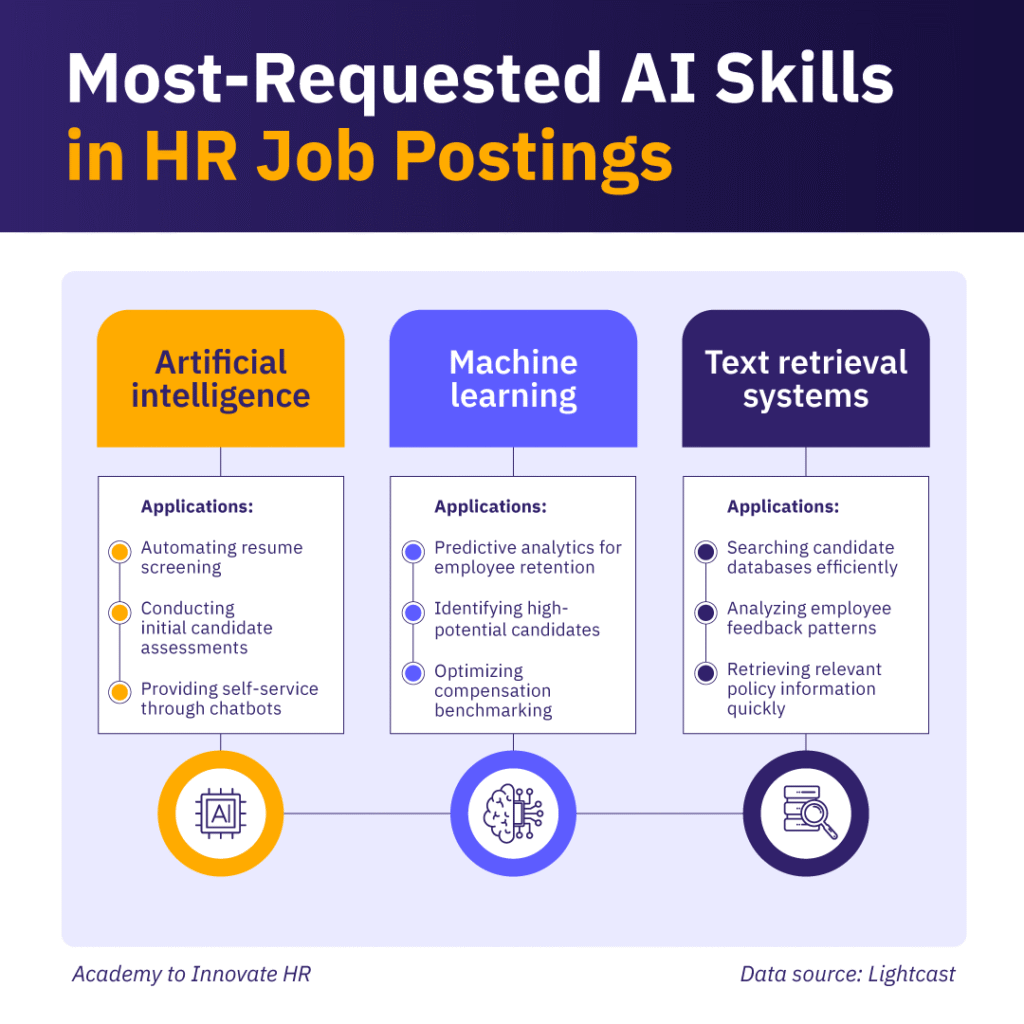
Why top-down change management is not the right approach in HR
Most organizations treat technology adoption as a top-down process where leadership sets a vision, managers operationalize, and employees are expected to implement and use the tech. However, HR’s AI journey has proven that this linear model is too slow and rigid.
With practitioners already experimenting and finding value, the old model of waiting for a polished, centralized strategy risks creating bottlenecks. By the time leaders complete planning cycles, competitors have already moved ahead with innovation.
Traditional change models are too slow to keep pace with the rapid spread of AI adoption. Instead of directing and instructing, leaders should set clear principles and guardrails that enable safe experimentation, supported by continuous feedback loops that allow them to steer and guide the change process.

This means that HR leaders need a revised change approach to managing AI adoption and will have to play a different role to make it successful. At AIHR, we refer to this approach as “bottom-up change enablement,” which fundamentally shifts the focus, mechanisms, and accountability of change management and adoption.
Some of the ways these approaches differ include:
- Leadership vs. Participation: Traditional change management is leader-driven, with strategy and vision set at the top. Bottom-up change enablement is employee-driven, with practitioners exploring, experimenting, and shaping the future state.
- Process vs. Adaptation: Traditional change follows structured programs with defined phases, milestones, and compliance requirements. Bottom-up change evolves organically through experimentation, autonomy, and local problem-solving.
- Top-down communication vs. Multidirectional dialogue: Traditional models rely on leaders explaining decisions from the top down. Bottom-up change thrives on open, multidirectional communication with continuous feedback loops.
- Planned outcomes vs. Emergent value: Traditional success is measured by implementing predefined outcomes. Bottom-up success is measured by realized value, adaptability, and ongoing innovation.
- Designated leaders vs. Distributed leadership: Traditional change management approaches assign responsibility to formal change agents or project teams. Bottom-up change distributes leadership, allowing anyone to step up and influence outcomes.
A bottom-up enablement approach reframes change and AI adoption as more flexible and continuous iterative cycles. The strategy shifts from designing transformation as a phased and planned approach to creating conditions where bottom-up energy can be safely harnessed, aligned, and scaled. In an environment where AI evolves faster than planning cycles, this adaptive model is the only way to capture momentum without losing control.
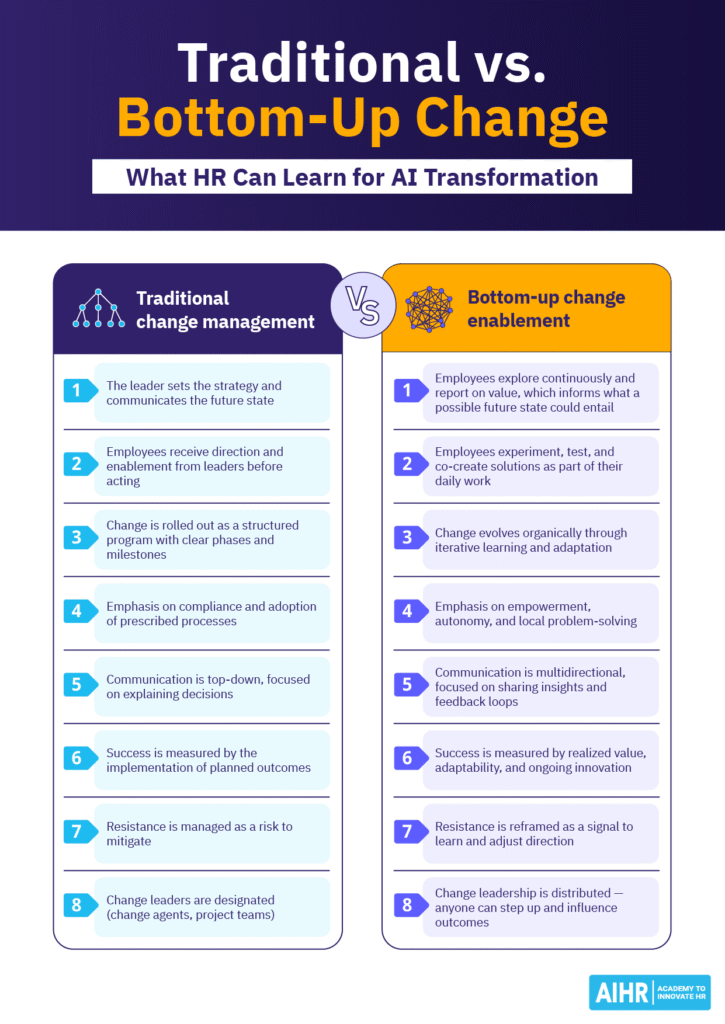
Implications and priorities for HR leaders
The role of the HR leader in this bottom-up change management approach is fundamentally different. Rather than exercising control, HR leaders create the conditions for change to emerge. This means setting clear guardrails that ensure experimentation happens safely and remains aligned with strategic objectives, while stepping back to allow teams the freedom to explore, adapt, and learn.
To enable this, HR leaders should focus on three priorities:
Redefine work, roles, skills, and development pathways
AI is reshaping what “core HR work” looks like. HR leaders should redefine roles to reflect how people and technology work together and include new technical skills in HR upskilling plans. At the same time, they must work on strengthening durable skills like coaching, ethical judgment, and communication in their teams. These skills become even more valuable as AI takes over routine tasks. Upskilling programs for HR teams should focus on building structured, role-specific AI fluency so practitioners move beyond experimenting with tools and develop real, transferable competence.
When training in AI fluency, it’s crucial to not neglect human skills. Our AI skill disruption index shows many of the skills required in HR are highly exposed to AI, but the most important skills remain deeply human, like leadership, communication, and strategy.

Cultivate and elevate grassroots innovators
The most promising AI adoption is already happening at the practitioner level in pockets throughout the HR function. To support this, HR leaders should actively identify, support, and amplify early adopters who are experimenting with AI in their work.
Positioning these team members as peer coaches, role models, and community builders fosters networks of practice that spread innovation organically while ensuring consistency in quality and standards.
Promote fast, safe experimentation
Encourage small-scale, low-risk pilots within HR practitioner teams, learn quickly, and scale the successes. Leaders provide the guardrails of ethics, compliance, and governance, while practitioners drive the practical application. This balance ensures speed without sacrificing accountability.
For HR leaders, this means creating structures that enable teams to develop the right skills and share their knowledge. Doing so transforms fragmented experimentation into a coordinated, organization-wide capability.
Ensuring that the HR team has the skills required to experiment safely and build the AI fluency needed for success is critical to creating these conditions.
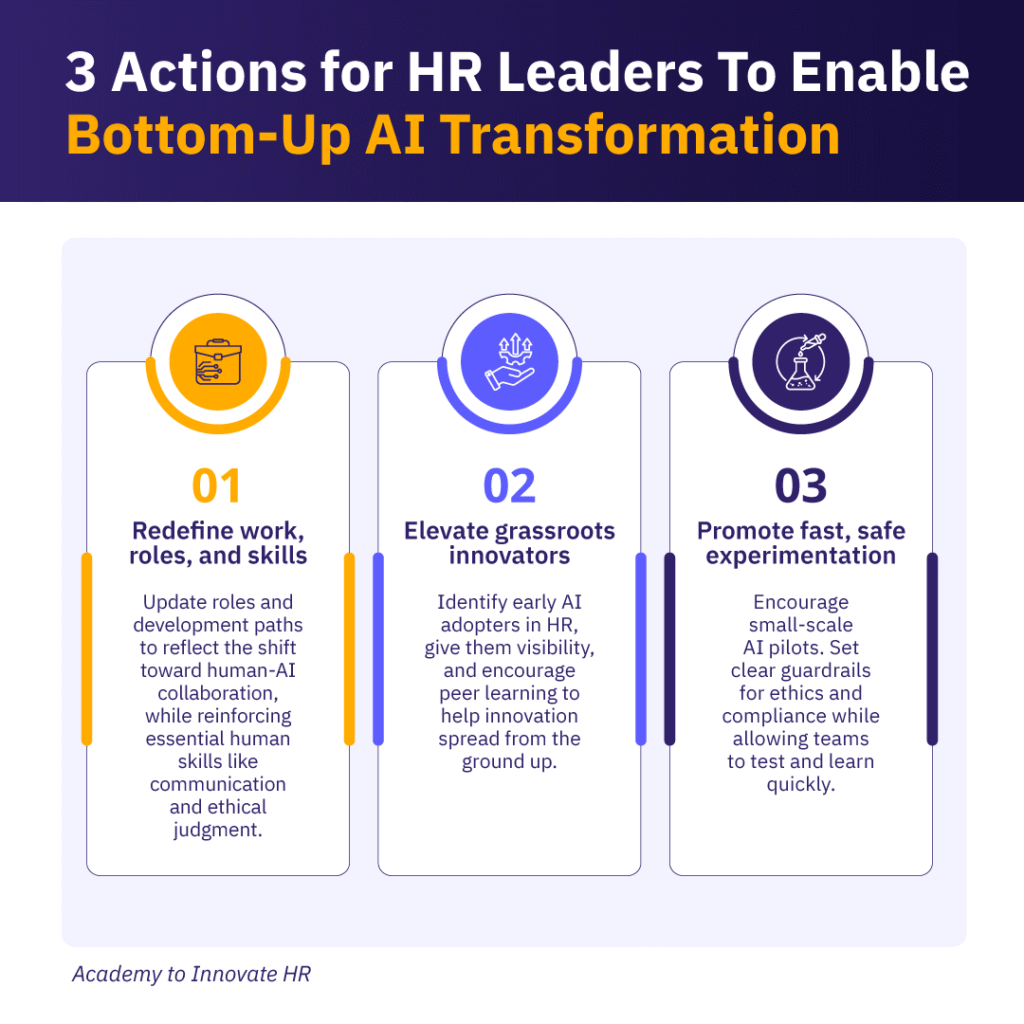
Building AI fluency in HR to leverage value from AI experiments
AI fluency is the ability to understand, apply, and integrate AI responsibly into everyday HR practice, combining technical confidence with human judgment. It goes well beyond just knowing how to use a tool.
AIHR’s definition of AI fluency includes these four domains every HR professional should be proficient in:
- Confident application: HR professionals must know where AI adds value across the employee life cycle and be comfortable using it in practice. They need to build confidence not just through theory, but through safe, hands-on opportunities to apply AI to real HR tasks, whether that’s automating candidate screening, summarizing employee surveys, or drafting policy documents.
- Responsible use: Apart from technical skills, true AI fluency requires ethics. HR teams must learn how to use AI fairly, inclusively, and transparently, ensuring employee trust is never compromised. This involves understanding data privacy, spotting potential bias in outputs, and consistently applying human oversight in sensitive decisions.
- Adoption advocacy: Every HR function needs visible champions who model effective AI use, share best practices, and encourage peers to experiment responsibly. Building advocacy into upskilling initiatives helps maintain momentum and makes AI adoption a standard practice rather than a siloed exception.
- Workflow integration: Finally, fluency means embedding AI seamlessly into HR processes, rather than treating it as an add-on. HR professionals should learn how to redesign workflows to make AI a natural extension of recruiting, learning, and workforce planning. This moves AI adoption from scattered pilots to sustainable impact.
Together, this helps HR professionals gain real competence and prevent creating false confidence through fragmented, one-off training. With structured development, practitioners can harness AI responsibly and effectively, turning individual experiments into organizational capability.
AI is set to change everything about the HR function in the years to come, whether we’re ready for it or not. By empowering first adopters to learn, experiment, and develop their expertise with these capabilities, HR teams can position themselves as leaders across their organizations.

To sum up
The adoption of AI across the labor market is accelerating faster than traditional workforce planning cycles can manage. Where email took a decade to achieve adoption, generative AI has progressed to the same point in less than three years. HR is not immune to this pace.
Frontline HR professionals are already experimenting with AI. They are the early adopters, building the future of HR in real time. The path forward is clear: HR leaders must invest in upskilling and AI fluency across their organizations and create the conditions for HR to leverage value from AI investments.
The real question is whether HR leaders will block AI progress or enable it.


